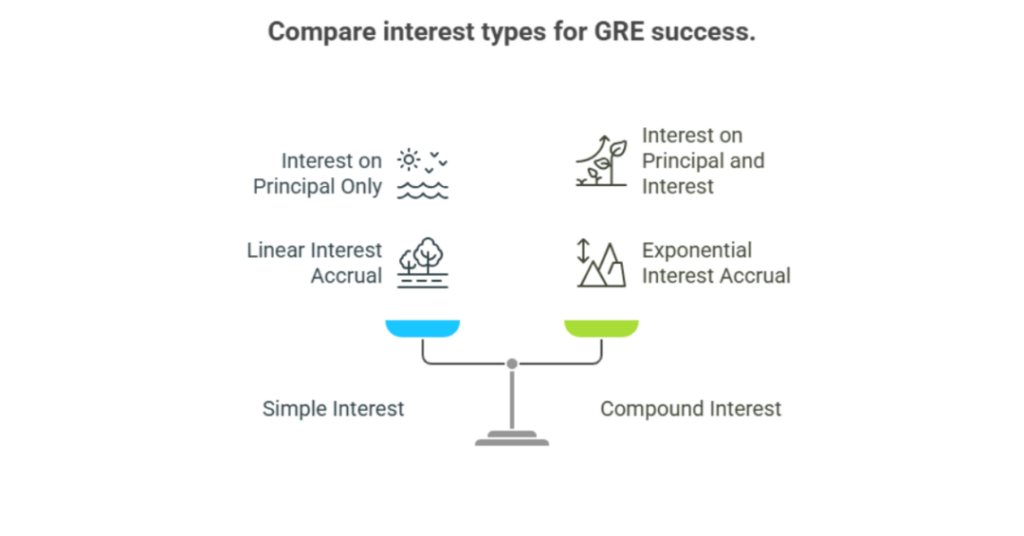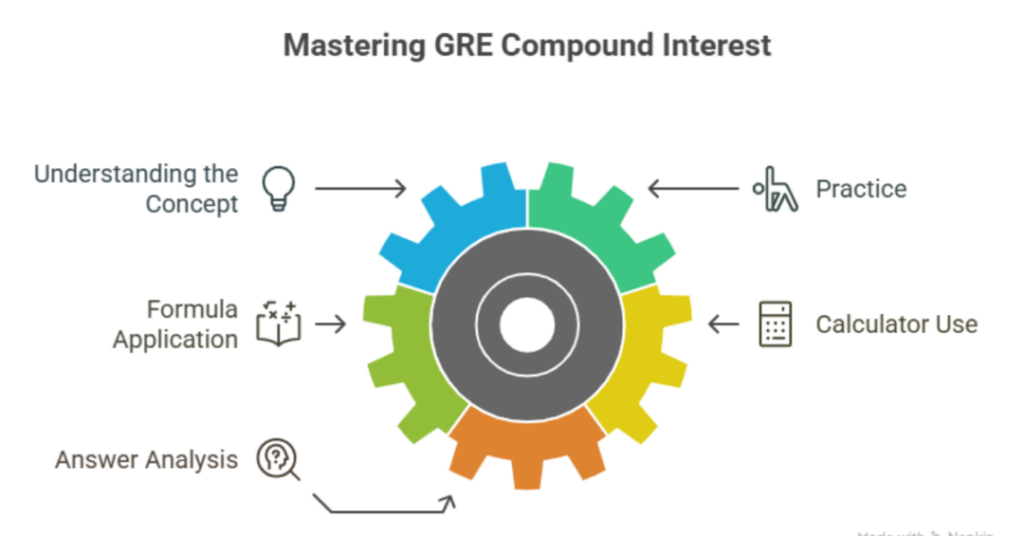31 May 2025
6 minutes read
What Is GRE Math Simple and Compound Interest (GRE Compound Interest)?

Key Takeaways
- Understand the differences between simple and compound interest to solve GRE math problems effectively.
- Practice using the correct formulas and GRE calculator to enhance your speed and accuracy.
- Focus on solving sample problems regularly to boost confidence and prepare for test day.
Understanding the concepts of simple and GRE compound interest can feel like deciphering a complex puzzle. Did you know that compound interest calculations form a crucial part of the GRE math section, making up a significant percentage of quantitative questions? Many test-takers struggle with these concepts, often finding themselves confused about how interest formulas play out in real-world scenarios. This is where most people go wrong in their GRE action plan.
But mastering this topic isn’t as daunting as it may seem. You can even master complex topics like GRE age problems with the right approach. With a solid grasp of the formulas and some practice, you’ll find that even the trickiest interest-related questions can become second nature. In this blog, we’ll break down these concepts, helping you prepare for the GRE math section with confidence.
What is Simple and Compound Interest?
Simple and compound interest are fundamental topics in GRE math. Simple interest is calculated on the initial principal only, while compound interest accrues on both the principal and the interest earned. To tackle GRE compound interest problems, you need to understand how interest is compounded annually, quarterly, or even semi-annually. The compound interest formula is key when calculating the total interest earned or accrued over time at a given annual interest rate. In the meantime, make sure to keep your GRE appointment number handy.

During your GRE prep, mastering how to calculate interest would help you confidently solve interest rate problems. Whether you’re working with compounded quarterly or compounded semi-annually interest rates, knowing how to apply the correct formula is crucial. Use practice questions and GRE test resources like free GRE flashcards to test your understanding. Remember, accuracy is key when dealing with calculations involving decimals, exponents, or the annual interest rate. With enough practice, finding the correct answer will feel second nature. GRE arithmetic problems can become your strong point this way.
How to Crack GRE Simple Interest?
Cracking simple interest problems on the GRE isn’t as difficult as it seems. Simple interest is straightforward: it’s calculated only on the original amount you invest, using a basic equation that doesn’t involve any compounding. The key is to practice regularly and get comfortable with solving these problems quickly during your GRE quant section. Have a clear idea of the GRE average score in India as well.
To solve simple interest problems, start by using the formula and multiply the principal by the interest rate and time. Whether you’re preparing through a GRE course or using a calculator for practice, the goal is to improve accuracy and speed. As with the LSAT or MCAT, test prep for the GRE often includes multiple-choice questions, so understanding how interest works when it’s applied once or twice a year is essential to finding the possible answer correctly.
Sample Simple Interest Problems for GRE
Sample simple interest problems for the GRE allow you to practice calculating interest based solely on the initial principal, helping you build confidence in solving these straightforward but essential math questions. Use the right GRE books to find relevant quant questions.
Question 1
A person invested $5,000 at a simple interest rate of 6% per year. How much interest will the person earn after 3 years?
Solution
To find the interest earned, we can use the simple interest formula:
I = (P × R × T) / 100
Where:
- I = Interest earned
- P = Principal amount (the initial investment)
- R = Annual interest rate
- T = Time period in years
Plugging in the values:
I = ($5,000 × 6 × 3) / 100
I = $900Therefore, the person will earn $900 in interest after 3 years.
Make it clear whether you can use a calculator during GRE exam.
Question 2
A person invested $10,000 at a simple interest rate of 5% per year. After how many years will the total amount (principal + interest) be $12,000?
Solution
To find the time period, we can rearrange the simple interest formula:
T = (100 × I) / (P × R)
Where:
- I = Total interest earned
- P = Principal amount
- R = Annual interest rate
- T = Time period in years
Given:
- I = $2,000 (since the total amount is $12,000 and the principal is $10,000, the interest earned is $2,000)
- P = $10,000
- R = 5%
Plugging in the values:
T = (100 × $2,000) / ($10,000 × 5)
T = 4 years.
Therefore, it will take 4 years for the total amount to reach $12,000.
Tips to Crack GRE Compound Interest Section
The GRE compound interest section can be challenging, but with the right strategies, you can crack it. Compound interest is different from simple interest, as the interest is compounded multiple times within a given period. For instance, if interest is compounded every six months or semi-annually, the rate of interest is divided accordingly.
This means that interest on a sum is calculated not only on the principal amount but also on the interest accrued. Many students struggle with this concept during their GRE prep, but practice and understanding how the interest is paid and compounded can make a big difference. Also, make sure to understand what a GRE cancel score is.

Let’s say you’re solving an example problem where a certain sum of money has an interest rate of 10% per annum, and interest is compounded half-yearly. The key is to break down the problem—whether the interest is compounded four times a year or semi-annually—and use the correct formula.
The original principal becomes the principal for the second period, and so on. As you practice, look at the answer choices carefully and use a GRE calculator to ensure accuracy. With each practice test, you’ll become more comfortable calculating the total amount and final value of your savings account or investment, so you can confidently tackle any compound interest word problems. If you are planning to reschedule or cancel the exam, make sure to understand GRE cancellation fee and other necessary info.
Compound Interest Sample Problems
Sample problems on compound interest help solidify your understanding of how interest is compounded on both the principal and the accrued interest over time, preparing you for the type of questions you’ll encounter on the GRE.
Question 1
A person invests $2,000 in an account that offers a compound interest rate of 5% per year, compounded annually. How much money will be in the account after 3 years?
Solution
To find the total amount after 3 years, we can use the compound interest formula:
A=P×(1+r)tA=P×(1+r)t
Where:
- AA = Total amount after time tt
- PP = Principal amount (the initial investment)
- rr = Annual interest rate (as a decimal)
- tt = Time period in years
Plugging in the values:
- P=2000P=2000
- r=0.05r=0.05
- t=3t=3
A=2000×(1+0.05)3A=2000×(1+0.05)3A=2000×(1.157625)A=2000×(1.157625)A≈2315.25A≈2315.25
Therefore, the total amount in the account after 3 years will be approximately $2,315.25.
Question 2
A sum of money doubles in 4 years when invested at a certain compound interest rate, compounded annually. What is the annual compound interest rate?
Solution
To find the compound interest rate, we can use the formula for compound interest and the fact that the amount doubles:
A=P×(1+r)t
A=P×(1+r)t
Since the amount doubles, we have:
2P=P×(1+r)42P=P×(1+r)4
Dividing both sides by P
P:2=(1+r)42=(1+r)4
Now, take the fourth root of both sides:
1+r=21/41+r=21/41+r=2≈1.1892071+r=2≈1.189207
Subtracting 1 from both sides gives:
r≈0.189207r≈0.189207
To express this as a percentage, multiply by 100:
r≈18.92%r≈18.92%
Therefore, the annual compound interest rate is approximately 18.92%.
Conclusion
Mastering simple and compound interest is key to excelling in the GRE math section. With consistent practice, a clear understanding of interest formulas, and regular use of tools like the GRE calculator, you’ll be well-prepared for any interest-related problems. By breaking down each problem, applying the right strategies, and honing your skills through sample problems, you’ll build the confidence needed to achieve your best score on test day.
Score Higher on the GRE: Ambitio’s Bootcamp is Your Secret Weapon! Gain insider knowledge and strategies from GRE experts, turning your prep into a strategic advantage on test day.
FAQs
How do I know when to use the compound interest formula on the GRE?
Use the compound interest formula when interest is accrued more than once a year, such as semi-annually or quarterly.
Is it important to memorize interest formulas for the GRE quant section?
Yes, memorizing key formulas like simple and compound interest saves time and helps you solve problems more efficiently.
Can I use the GRE calculator for all interest-related problems?
While the GRE calculator helps with complex calculations, you should practice solving interest problems manually to reinforce your understanding.
What should I focus on when practicing simple interest problems?
Focus on understanding the relationship between the principal, rate of interest, and time to calculate the interest quickly and accurately.
How can I approach compound interest problems if the interest is compounded quarterly?
Divide the annual interest rate by four and adjust the number of periods accordingly to reflect the quarterly compounding.
What’s the best way to avoid mistakes in interest word problems on the GRE?
Carefully read each problem, identify the correct formula, and double-check your calculations to avoid common errors.
How can I improve my speed with interest-related questions during the GRE?
Regularly practice with timed sample problems and focus on identifying shortcuts, such as breaking down the calculations into simpler steps.

You can study at top universities worldwide!
Get expert tips and tricks to get into top universities with a free expert session.
Book Your Free 30-Minute Session Now! Book a call now




























